BY WILLIAM M. ARKIN
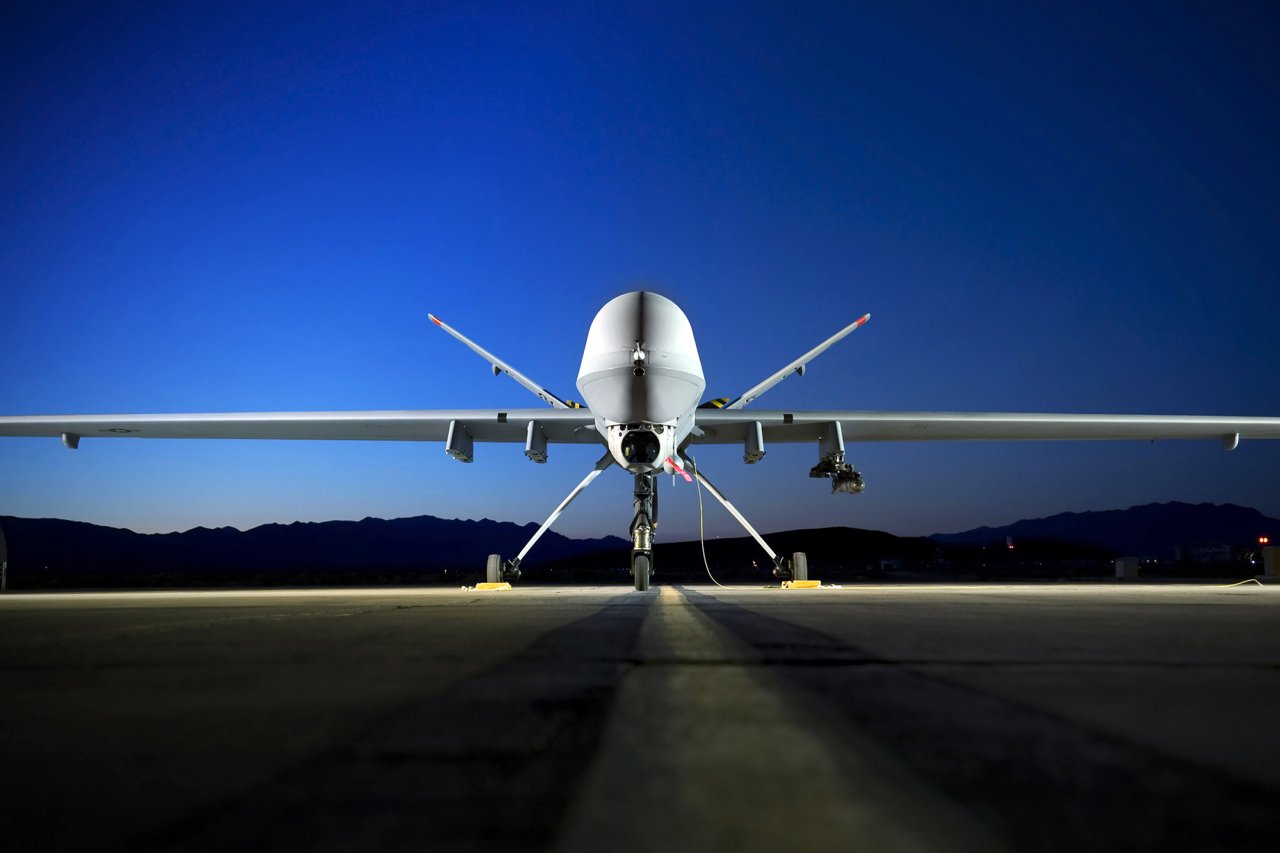
Apeace agreement with the Taliban and a May 1 deadline for American withdrawal of troops. A new pledge by President Biden to end the war. A Congressional step toward revoking the 20-year-old consent to use military force in Iraq. Talk, even, of rescinding the post-9/11 authorization to pursue Al-Qaeda. You might think America's forever wars are finally coming to an end. They're not—because everything we've learned from the past two decades at war has made it more difficult to actually end the wars.
Though the new administration seems intent on ending America's oldest war and there is growing fatigue over endless wars in the Middle East, and though the Pentagon is scrambling to refocus resources and attention away from counterterrorism to big war pursuits against the likes of Russia and China, war isn't going to actually end. That's because there is something about the way the United States fights—about how it has learned to fight in Afghanistan and on other 21st-century battlefields—that facilitates endless war.
This transformation of the American military happened gradually as the armed forces shifted the preponderance of tasks away from boots on the ground, away even from dependence on regular soldiers. The new American way of war moved even the means of bombing and killing—mostly through aircraft and drones, but also virtually in cyberspace—out of the actual war zones.
Troops shrunk in importance. There were no more armies to fight, no countries to occupy, and no appetite even to engage in hand-to-hand combat that put American lives at risk. What emerged is a certain kind of fighting, sustained by a flexible and reliable global network. The traditional measures of troop presence have become irrelevant while the means of actual warfare became invisible.
Take Afghanistan, for example. President Biden now says that the last remaining 2,500 "troops" in country will be withdrawn by the end of the year. And indeed, the last of the regular Army and Marine Corps units will come home. But these are not the only soldiers in the country, and the fighting—even on the ground—has shifted away from infantry to clandestine special operations and CIA paramilitaries. They exist uncounted, hidden behind a veil of secrecy and ignored in public tallies.
Fighting alongside them are others, also not troops. "Trainers" and technicians help Afghans to operate the billions' worth of equipment we've provided. The semi-combat elements of other agencies—the DEA and State Department, even the FBI—fight alongside them too, battling drugs, human trafficking and even corruption.
And then there are private contractors, who have become more and more intrinsic to everything military, even frontline operations. In Afghanistan, civilian contractors outnumber soldiers 7 to 1, and these non-soldier soldiers increasingly take on more and more direct military tasks. In fact, 54 different defense companies are right now advertising job openings in Afghanistan, looking for technicians to do everything from intelligence analysis and terrorist targeting to air conditioning repair.
The American way of war enables both troop withdrawals and continued fighting because over two decades of continuous warfare, new capabilities have emerged that fundamentally reorder the calculus on the ground. Capabilities that didn't even exist before 9/11—armed drones, autonomous precision strike, total surveillance, cyber warfare—have emerged and matured. But most important, The bulk of what sustains warfare in Afghanistan is located in the "safe" countries of the Middle East, even in Europe, and an increasingly larger proportion resides in the United States itself.
Linking this machine together is a global network that collects and processes mountains of information, moves that information around, sustains a worldwide targeting system, generates long range attacks, and makes most of the decisions. This extraordinarily complex network involves the participation of half the countries on earth. A hub—made up of giant command and intelligence centers—feeds spokes reaching out throughout the Middle East and South Asia, and into Africa and Asia. It is so little understood, so invisible, so resilient and so efficient, even as four successive presidents have promised and then tried to stop warfare, the spokes have grown and extended.
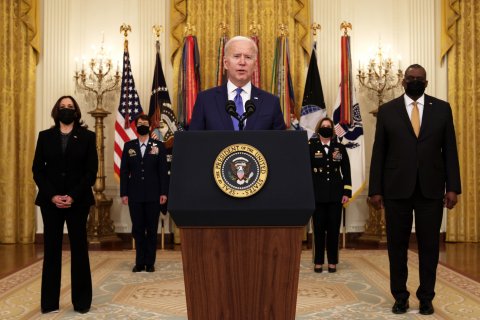 President Biden vows the Pentagon will move forward “in a transparent and principled manner.”ALEX WONG/GETTY
President Biden vows the Pentagon will move forward “in a transparent and principled manner.”ALEX WONG/GETTYPerpetual war is this newly created machine itself. Today, that system comprises some two dozen countries where the U.S. is regularly bombing and killing. The American model facilitates "withdrawal" because with it, the very importance of "troops"— of actual boots that might be worn by soldiers on the ground—has virtually disappeared as a central element of killing terrorists. The consequence is not just that perpetual war increasingly takes place out of sight, but with fewer soldier deaths and injuries due to changed tactics and increasingly remote attacks, war also has become more and more irrelevant to American lives.
In our topsy-turvy world, the United States today is killing or bombing in perhaps 10 different countries. Some we know for sure: Afghanistan, Iraq, Syria, Pakistan, Somalia, Yemen. Some occasionally are acknowledged—Libya, Niger, Mali and Uganda. Others are more obscure—Burkina Faso, Cameroon, Chad, Lebanon, Nigeria. And still others—the Philippines, Central African Republic, Ethiopia, Eritrea, Kenya, Thailand—are alluded to in fleeting news reports or hinted at in military deployments and supposed war games with host nation forces.
Beyond these 21 countries, American special operations forces are routinely present in some 70 additional countries, sometimes with partners and sometimes operating unilaterally, sometimes fighting against terror, and sometimes "fighting" against the endless forces of transnational organized crime, and sometimes even just collecting intelligence information and "preparing the battlefield" for future operations.
At the center of warfare in these countries—at the center of the perpetual war machine—are the back-end hubs of the Middle East, commands and bases in the supposedly safer countries outside combat zones—places like Jordan, Kuwait, Bah- rain, the United Arab Emirates, Qatar, Oman, Saudi Arabia and Djibouti. Here, the main headquarters are located, as are the main combat air and naval bases. The center of all air operations—the most important of all the centers—is located in the tiny Gulf state of Qatar, the army hub is in Kuwait, the navy hub is in Bahrain. This is where the majority of the preparatory work takes place.
In every country at the edge of this worldwide hub-and-spoke design where the actual bombing and killing takes place, the same Afghanistan math and model persists: There are acknowledged and unacknowledged forces; contractors mostly outnumber soldiers, operating clandestine and "low visibility" activities that substitute for the official and the acknowledged, and most of the lethal attacks come from outside the country. And the list of missions—policing the drug trade and stemming transnational organized crime, countering the proliferation of weapons of mass destruction, dealing with long-range missiles and drones now owned by all, fighting cyber threats, defeating piracy, stopping illegal migration—justifies fighting almost everywhere.
The hub and the spokes are meshed together into a literal network—terrestrial, over the internet and in space—a global sensing and communicating machine which connects everyone "forward" and ultimately back to dozens of bases in the United States. So few are at the tip of the spear but that spear is also supercharged and precise, offering unprecedented flexibility. A hub that might be receiving and triaging intercepts or directing and flying drones one day with a focus on Syria can shift the next day to Libya, from Somalia one day to Nigeria the next.
Nowhere is this flexibility seen more clearly than in the January 3, 2020, drone strike that killed Iran's Quds force commander General Qasem Soleimani as he was leaving Baghdad International Airport. It was a masterful demonstration of expertise and America's unique global reach—of the perpetual war system itself.
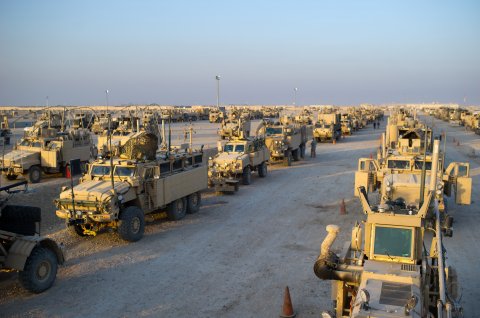 US soldiers prepare the last convoy carrying US troops at Camp Adder on the outskirts of the southern city of Nasiriyah on December 17, 2011, marking the withdrawal of US troops from Iraq.MARTIN BUREAU/AFP/GETTY
US soldiers prepare the last convoy carrying US troops at Camp Adder on the outskirts of the southern city of Nasiriyah on December 17, 2011, marking the withdrawal of US troops from Iraq.MARTIN BUREAU/AFP/GETTYWhile Trump administration officials deliberated in Washington and at Mar-a-Lago as to whether to pull the trigger, they never really had to ask about the how or even the likelihood of success. Behind the scenes, hundreds of uniformed specialists, civilians and contractors "worked the target," finding and then tracking the general's movements, intercepting and translating his (and other Iranian and Iraqi) communications, scheduling everything from satellite time to pilot shifts, preparing the drones and the other over-watch aircraft needed to fly, loading and arming the bombs that would be used, timing the movements, carrying out the air traffic control and complex choreography that was needed to bring it all together, even making the contacts with the involved governments to clear airspace and clear consent.
Thousands more kept the communications and networks open to support these "frontline" few, manning the command centers and headquarters, preparing the target graphics and preparing the briefings for the decision makers, providing minute-by-minute updates. These many thousands were spread out from local bases in Iraq and the Persian Gulf states to the military decision-making hub in Florida, to Georgia, where the listening and translating mostly occurred, to South Carolina, where the air effort was overseen, to dozens of other agencies and organization in the D.C. metropolitan area where the reconnaissance data was downloaded and processed.
It was a worldwide effort where the number of boots on the ground was utterly immaterial. The new American way of war means uniformed personnel, government civilians and private contractors leaving their homes throughout the United States to go to "war" in remote parts of the world, then returning home when their day of bombing and killing is over.
The killing of General Soleimani is not the exception. Since the new American way of war started as an effort to kill Al-Qaeda leaders and lieutenants, individuals have come to dominate the entire killing effort, even against the Islamic State. Other than small parts of Afghanistan, Iraq and Syria, there are no real armies left to fight on the ground (or at least no desire to fight them force-on-force). For the United States, there is little interest in engaging terrorists in any kind of close hand-to-hand combat (that's the job of Afghan, Iraqi, Syrian and Kurdish "partners"). America—with its global network and possession of the greatest targeting information ever known to mankind—is the enabler of local and proxy killing.
The American focus—this machine's focus—is on finding and killing individuals, the more "high-value" the better. Targeting is the centerpiece of American global operations, the same information machine shifting from country to country and group to group almost seamlessly. This shift is even increasingly unconstrained by either language or culture. With a 21-nation battlefield against dozens of terrorist organizations on three continents, techniques like machine translation and big data exploitation are increasingly employed to process the Niagara of information.
Yet while there is no question that artificial intelligence enables greater flexibility, there is also a price. We are now 20 years into the era of post-9/11 perpetual war and there is still a scandalous shortage of linguists in the ranks (necessitating much of the outside contracting) and also a dearth of actual country and regional expertise. Even in Afghanistan, where perpetual war began in October 2001 and where the Pentagon has undertaken countless programs to build local expertise—foreign area officers, Afghan "hands," regionally oriented units—there is a contract linguist hired for every three soldiers.
The expertise that is truly valued is that which is necessary to operate the giant perpetual war network and all of the supporting software. Long-range precision targeting in an era of satellite navigation and individual weapons guidance that increasingly is able to autonomously loiter and search just needs a set of precise geographic coordinates where the target is located to do its job. It doesn't matter if it's Kabul or Kampala, Baghdad or Bangui.
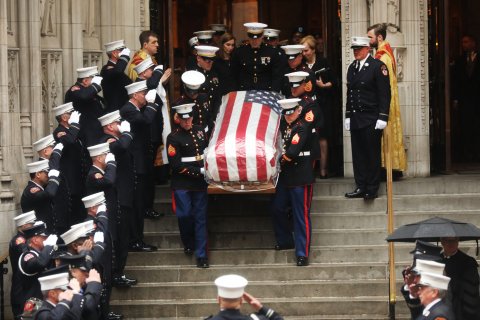 The casket of firefighter Christopher Slutman leaves St. Thomas Church on April 26, 2019 in New York City. The Marine Corps Staff Sgt. was among three American service members killed by a roadside bomb in Afghanistan on April 8.SPENCER PLATT/GETTY
The casket of firefighter Christopher Slutman leaves St. Thomas Church on April 26, 2019 in New York City. The Marine Corps Staff Sgt. was among three American service members killed by a roadside bomb in Afghanistan on April 8.SPENCER PLATT/GETTYGenerating those coordinates demands endless numbers of back-end workers. As the U.S. war machine has developed, it isn't quite at the point where everyone is sitting at some remote keyboard, but the preponderance of those who "fight" this new kind of perpetual war are supporting a very small number of troops on the ground (or pilots in the air) who are actually in harm's way in places like Afghanistan or Iraq. It is a ratio of hundreds of thousands to one.
The efficiency is grossly misunderstood by those who count troops and believe the happy talk that emanates from officialdom that progress is being made, that forces are being withdrawn or that "ending" wars means either ending a war or connotes success. Another feature of perpetual war is that such deceptive and soothing war dispatches can be issued because one of the consequences of taking soldiers out of the equation of war is that the physical reality of actual combat—the sounds and smells of war—has grown distant to nearly everyone else in the machine. That's the internal effect.
Externally, the dominant position of information over metal maximizes American advantages while minimizing the number of American lives at risk. There is a double desire in the armed forces to avoid American deaths and injuries while also minimizing civilian casualties. First, minimizing American deaths and injuries is a sound military objective and a political necessity. Minimizing civilian harm is a humanitarian and strategic objective (as well as a legal requirement). But neither are altogether altruistic goals. Efficiency minimizes mistakes which thus suppresses news and thus facilitates frictionless continuation, free from interference from Congress, the public, the news media or even local governments.
Simply, the American way of war has become to make war as invisible as possible, not just because counterterrorism demands some special degree of secrecy, but also because operating in secret—at least secret from the American public—lets the government and the military continue without interference. Neither Congress nor the public has particularly clamored for transparency or an audit, and the national security establishment assumes that the American public doesn't want to know, which is to say that it doesn't want to be bothered by war because it largely doesn't have a stake in what happens and nor is it prepared to sacrifice anyway.
Unaudited and with poor measures of success, the Biden administration can assert that the Afghanistan war is ending because some level of stability has been created. This is despite consistent intelligence assessments that predict a disaster after the American withdrawal. Visiting Kabul last month, Secretary of Defense Lloyd Austin limited himself to saying that there would be a "responsible end" to the war, "responsible" mostly meaning that the paperwork would all be in order—that government consensus will be hammered out and obtained, that Congress will be neutralized, that the national security establishment will be silenced because it has run out of better ideas, that the Afghan government agrees (or is effectively bought off) and that American allies are on board. And finally, "responsible" means that no Americans will get injured or killed in the actual bug-out, that the scenes will be pleasing and triumphant.
 U.S. service members walk off a helicopter on the runway at Camp Bost on September 11, 2017 in Helmand Province, Afghanistan.ANDREW RENNEISEN/GETTY
U.S. service members walk off a helicopter on the runway at Camp Bost on September 11, 2017 in Helmand Province, Afghanistan.ANDREW RENNEISEN/GETTYIt's worth noting that this claim of being "responsible" was almost the exact same formulation General Lloyd Austin used when he was commander of U.S. forces in Iraq in 2011 when combat there was declared over as well, with a similar "withdrawal" of combat troops and with the Obama administration praising itself for ending "Bush's war." That is, before the Islamic State rampaged and the Iraq partners crumbled and the United States had to go back in 2014, bombing and killing in Syria and Iraq, where it still is engaged today, Afghanistan-style, increasingly remote and constantly struggling to minimize the number of troops involved and the level of American risk.
In the end, can anyone honestly look at the Middle East and say that there's been any success in two decades of war? That is, other than the laboratory success in building the capabilities of the American war machine and the global network. There is no question that as this system has matured, the number of American soldiers being killed and injured has dramatically declined. In fact, starting in about 2010, the number of contractor deaths and injuries began to exceed those in uniform.
Still, in 20 years of fighting, there have been almost 11,000 American deaths (including contractors) and more than 53,000 American have been physically broken, while countless others suffer from traumatic brain injuries and other post-traumatic disorders. The monetary cost to the American taxpayer is as much as $6.5 trillion, more than the defense budget of all the other nations combined, over six years of spending. It's twice the cost of annual health care for all Americans. It's 10 times the annual budget of the entire American public school system.
On February 25, U.S. fighter aircraft struck infrastructure targets in eastern Syria that it said were being utilized by Iranian-backed militant groups. The Pentagon announced that the strikes were "at President Biden's direction" and the news media reported that it was the first use of military force by the new administration.
Two days after the attack, the White House reported to Congress that the "United States always stands ready to take necessary and proportionate action in self-defense, including when...the government of the state where the threat is located is unwilling or unable to prevent the use of its territory by non-state militia groups responsible for such attacks."
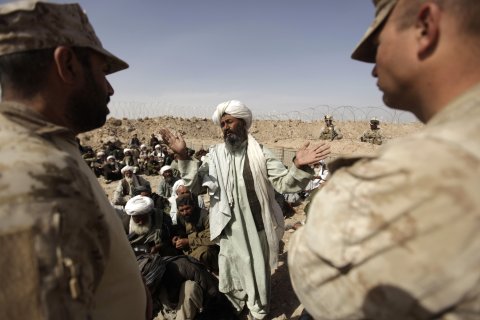 US Marine and his translator listen to an elder from Trikh Nawar during a meeting with community leaders in the northeastern outskirts of Marjah on February 20, 2010.PATRICK BAZ/AFP/GETTY
US Marine and his translator listen to an elder from Trikh Nawar during a meeting with community leaders in the northeastern outskirts of Marjah on February 20, 2010.PATRICK BAZ/AFP/GETTYThat's a dense Washington mouthful to decipher. First, though there's no mention of terrorism, the use of the term "non-state militia groups" intentionally expands the target description to include local insurgents but also drug cartels or organized criminal enterprises. Second, the unilateral justification—the administration is now explicitly saying that the United States will take action when a country where some nefarious activity is taking place doesn't, either because it is unwilling to or unable to do so. This Biden administration articulation isn't any different than the practice of the previous three administrations, but it serves as notice to Congress that "I told you I was going to do this" may be used to cover attacks that might be undertaken in the future.
The United States isn't quite back to the Clinton administration's humanitarian interventions of the 1990s, where protecting human rights was the doctrine to justify the use of military force in places like Somalia or the former Yugoslavia. But it also isn't the Congressionally approved, post-9/11 authorization to use military force against terrorism, against those responsible for the attacks. President Biden wrote to Congress, in justifying the Syrian attacks, that he directed military action "consistent with" his responsibility "to protect United States citizens both at home and abroad and in furtherance of United States national security and foreign policy interests, pursuant to my constitutional authority to conduct United States foreign relations and as Commander in Chief and Chief Executive."
If you think it might take a lawyer to parse out when military action isn't permissible under this formulation, you wouldn't be wrong. It takes hundreds working in the bowels of the national security establishment. Meanwhile, while Congress has taken a first step to repealing the now two-decades-old authorizations, there is no honest accounting of the where, how and why we're killing—how United States citizens are being protected and what security benefit are actually accruing to the United States in continuing perpetual war. The Biden administration seems to be making an end run on Congress and the public, embracing the model of minimal interference while also showing no intention of disrupting the machine itself.
This subtle shift in articulating why we continue to fight around the world is also seen in Secretary Austin's three-page introductory "Message to the Force" issued in March. Austin literally does not say the word "terrorism" in describing the priorities of the armed forces, only saying that as the Pentagon addresses accelerating competition in China and deals with the threats from Russia, Iran and North Korea (the priorities), it will also "disrupt transnational and non-state actor threats from violent extremist organizations, such as those operating in the Middle East, Africa and South and Central Asia."
That geographic broad brush is the battleground of perpetual war. It is a gilded quagmire of our own making.
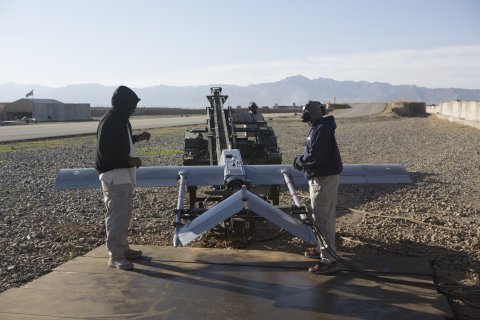 Two civilian contractors prepare a US Army 14' Shadow surveillance drone before it's launched at Forward Operating Base Shank May 8, 2013 in Logar Province, Afghanistan.ROBERT NICKELSBERG/GETTY
Two civilian contractors prepare a US Army 14' Shadow surveillance drone before it's launched at Forward Operating Base Shank May 8, 2013 in Logar Province, Afghanistan.ROBERT NICKELSBERG/GETTYAustin also promises—as does President Biden—that the Pentagon will move forward "in a transparent and principled manner." In this objective, it is already failing. That February 25 strike in Syria? It was not the first of the Biden administration. But unless one had inside information, it would be difficult to determine that. The government stopped making regular strike summaries publicly available more than a year ago, and the Biden administration has taken no action to reverse that practice and be more transparent.
When Newsweek inquired about the numbers of Syria strikes that had taken place before February 25, the responsible command replied, "The process of gathering the information takes time, and we release it as soon as it becomes available." Not only has no data been released, but the Pentagon has also stopped issuing biweekly "progress highlights" from Syria and Iraq.
With regard to Afghanistan, the Defense Department Special Inspector General has also repeatedly complained that data on strikes, on Afghan military readiness and on the state of the many terrorist groups operating in country—data that previously was made available—has also been classified and kept from the public.
When it comes to other battlefields, public accounting is equally avoided, even when it is required by law. The president's "war powers" reports to Congress omit mention of fighting in controversial countries merely by declaring them "classified." The Secretary of Defense has also certified that reporting on certain countries is no longer necessary, not because the fighting has ended, but because U.S. "troops" haven't spent more than 60 days in country or the operations cost less than $100 million annually. In this way, reporting on U.S. bombing and killing in Yemen and Lebanon, in East Africa and in "Northwest Africa"—already sparse—has disappeared altogether.
 There will be a “responsible end” to the war in Afghanistan, Defense Secretary Lloyd Austin (pictured) has said.MICHAEL REYNOLDS/EPA/BLOOMBERG/GETTY
There will be a “responsible end” to the war in Afghanistan, Defense Secretary Lloyd Austin (pictured) has said.MICHAEL REYNOLDS/EPA/BLOOMBERG/GETTYWhile that information has disappeared from the view of the American public, terrorist groups certainly know that the United States—even in the form of contractors who pretend to be locals—are there and attacking. Local populations know as well.
So, to put it bluntly, despite so much activity, despite the sacrifice of so many lives, despite enormous cost and despite countless excuses and justifications behind why we cannot stop fighting, we are neither defeating our enemies nor are we creating the conditions to become more secure. Yes, Saddam Hussein and Osama bin Laden are gone. But associating those special operations with success epitomizes the individualistic approach rather than representing any kind of honest assessment of greater security now or in the future.
After two decades of fighting, in fact, not one country in the Middle East—not one country in the world—can argue that it is safer than it was before 9/11. Every country that is now a part of the expanding battlefield of perpetual war is an even greater disaster zone than it was two decades ago.
It's clear that "ending" war in Afghanistan is not based upon the achievement of peace or stability, is not the result of the defeat of Al-Qaeda or the Taliban and comes amidst dynamic growth of the local affiliate of the Islamic State. For the future, continued fighting—even if it takes place under a new guise and hidden from view—will itself be stimuli for America's many enemies, who multiply and spread, thus ensuring perpetual war.
Perpetual war is a macabre bargain we live with. After 9/11, it seemed that the United States would pursue terrorists with every means possible and that the war would be ferocious, bloody and quick. But the American military also has its own culture—technologically driven, risk averse, precise—that condemns us to our own endless assembly line of doing what we are doing forever. Ending perpetual war isn't a formula, and the spread of the machine is so broad and ubiquitous that any single set of policy proposals—to stop fighting in this or that country or to eliminate this or that pro- gram—runs into unstoppable arguments. In the final analysis, ending perpetual war really means a psychological shift, one that derives from understanding the physicality of what's going on and one that demands an unsentimental look of what we're actually accomplishing.
No comments:
Post a Comment